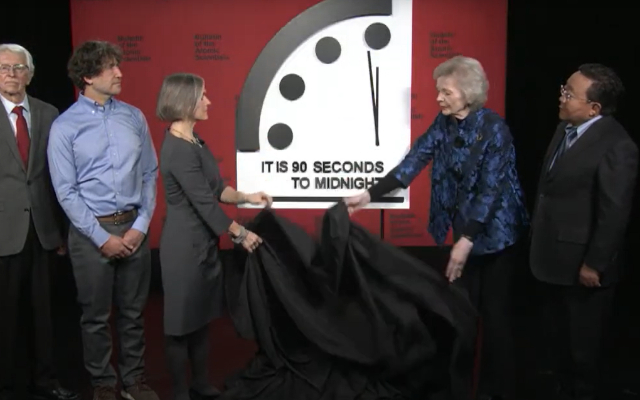Never heard of it? If you’re a Boomer, you’ve been deathly aware of it your whole life. For the young, and the uninitiated, it’s a metaphorical ‘clock’ that measures how close the human race is to destroying itself. But you can help turn back the Doomsday Clock!
 Members of the Doomsday Clock Committee unveil the 2024 setting…
Members of the Doomsday Clock Committee unveil the 2024 setting…
If the Doomsday Clock ever strikes Midnight, we’ll never know it. Humankind will have been obliterated by some apocalypse of its own making, or of natural causes.
How it works
The DDC has been ‘ticking’ for 77 years. Since the dawn of the nuclear age. It was originally intended to dramatize how close we were to mutually-assured nuclear destruction – ‘MAD’ as the politicians and media morbidly shorten it.
It was created in 1947, just after the Second World War, by J. Robert Oppenheimer and his fellow US scientists who had developed the first atomic bomb.
“It’s an imperfect metaphor,” Michael E. Mann, Presidential Distinguished Professor in the earth and environmental science department at the University of Pennsylvania, told CNN in 2022, highlighting that the clock’s framing combines different types of risk that have different characteristics and occur in different timescales. Still, he adds it, “remains an important rhetorical device that reminds us, year after year, of the tenuousness of our current existence on this planet.”
A select committee of scientists and scholars, which includes 9 Nobel Leaureats, decides on the setting for the DDC every January. It’s an organ of the Bulletin of Atomic Scientists.
Where it’s at
The least threatening the DDC has ever been was 17 minutes to midnight, at the end of the Cold War. Now, it’s hovering at 90 seconds to midnight. The war in Ukraine, the Israel-Gaza clash and other current conflicts have caused the Clock to remain perilously close to The End.
But this year, for the first time, the rise of Artificial Intelligence is being factored into the Clock’s setting. IT, “raises a variety of questions about how to control a technology that could improve or threaten civilization in countless ways,” says Bulletin CEO Rachel Bronson.
Also for the first time, the committee is considering the threat of climate change to humanity’s future. And that’s where you come in.
What you can do
“We at the Bulletin believe that because humans created these threats, we can reduce them,” Bronson says. “But doing so is not easy, nor has it ever been. And it requires serious work and global engagement at all levels of society.”
We can all talk up the climate crisis with our families and friends, Bronson says, to raise awareness. “You might not feel it because you’re not doing anything, but we know that public engagement moves (a) leader to do things,” she observes.
We can all consider how much we walk, versus how much we drive. How our homes are heated. And, of course, our daily habits. Eating seasonally and locally, reducing food waste, and recycling properly are all ways we can help fight the climate crisis.
My take
Fighting the climate crisis – as well as thinking rationally and critically about how AI can and should fit into our society – can go a long way to turning back the DDC. If we all pitch in and help.
~ Maggie J.

